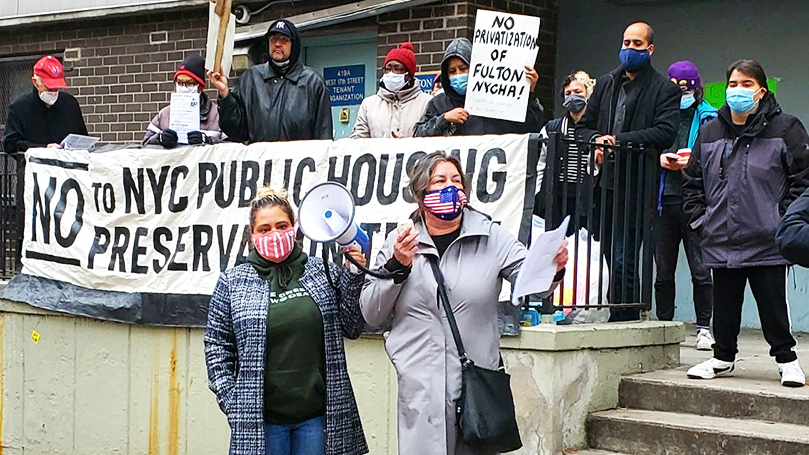
The New York City Housing Authority (NYCHA) is trying to privatize public housing, but the residents of Fulton Houses in Chelsea aren’t putting up with it.
Members of the New York Young Communist League; Communist Party USA; Movement School, a project of Organize for Justice; and Justice for All Coalition stood with the tenants at a rally on November 29 as they renewed protests of the de facto privatization of Fulton Houses and nearby Chelsea-Elliott Houses.
Under the cover of the pandemic, city officials have been going forward to convert a third of the city’s public housing stock to privately managed Section 8 housing, a proposal that met fierce resistance when it was first proposed for Fulton Houses, one of lower Manhattan’s largest remaining public housing developments, in 2018.
The city’s plan for conversion of Section 9 public housing to the Section 8 housing voucher program stems from a 2012 federal policy put forward by the Obama administration known as “RAD” (Rental Assistance Demonstration). So far, 94,000 public housing units nationwide have been converted to RADs. In New York City’s proposed implementation of it, referred to as “PACT” (Permanent Affordability Community Together), the multi-billion-dollar shortfall of NYCHA investment will be remediated not only by bringing in private developers to manage properties, but also by “infilling” spaces deemed “underutilized” — that is, build market-rate complexes — and selling air space above NYCHA developments to private developers to expand existing adjacent properties, all of which the city claims is the only way to “save NYCHA.” In practice, however, these plans amount to an overhauling of the public nature of public housing. And many tenants don’t want it.
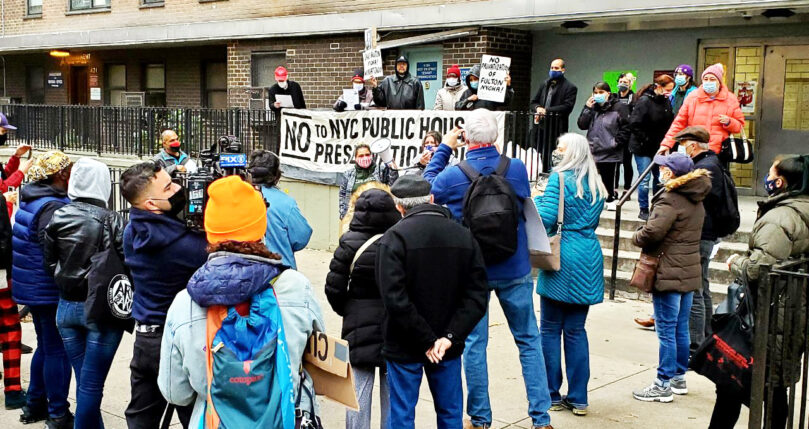
Jackie Lara, the main tenant organizer at Fulton Houses who has lived there for 18 years, has been fighting RAD since it was first proposed for Fulton in 2018. She said that during this time, there has been a significant uptick in property damage, which is being neglected in what she claims is an effort to push tenants to accept RAD out of desperation. She told protestors at the rally:
I came from a homeless shelter to make Fulton my permanent home. And now, de Blasio is giving our development to private developers. There has been a lot of sabotaging going on at Fulton, doors and windows being broken, but they don’t want to fix any of it. This behavior was never seen at Fulton since I’ve been here. Fulton is a beautiful development, even though they have neglected it. I love living here. My children love it here. Public housing is the only way we can afford to live and have a decent home. We have been protesting for over two years to save Fulton and have collected over 600 signatures of heads of household against RAD. We just want to keep it public housing. We matter, and our voices matter too.
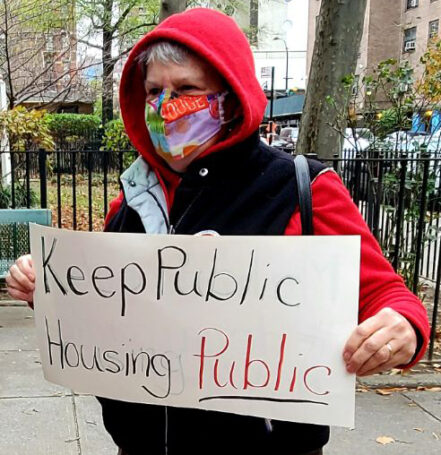 Part of the trickiness in criticizing RAD is the murky status of who in fact has more control in the public-private partnership it outlines. Because land is not sold off to private developers, RAD’s defenders can deny the accusation that it is a form of privatization. Although the city retains ownership, the management of the property, and the possibility of new constructions built on it for private, market-rate rental, effectively amount to the first steps in diminishing the exclusively public nature of public housing. In the move from Section 9 public housing subsidy to the Section 8 housing voucher program, the federal funding that the NYCHA relies on is secured while adding in private revenue streams or, as HUD puts it, avenues to “leverage the private capital markets to make capital improvements.” In the case of Fulton Houses, these streams were envisioned as flowing from the demolition of two of the 11 buildings in the development and their replacement by new apartment complexes at market rate. (The median one-bedroom rental price in Chelsea currently stands at around $3,600).
Part of the trickiness in criticizing RAD is the murky status of who in fact has more control in the public-private partnership it outlines. Because land is not sold off to private developers, RAD’s defenders can deny the accusation that it is a form of privatization. Although the city retains ownership, the management of the property, and the possibility of new constructions built on it for private, market-rate rental, effectively amount to the first steps in diminishing the exclusively public nature of public housing. In the move from Section 9 public housing subsidy to the Section 8 housing voucher program, the federal funding that the NYCHA relies on is secured while adding in private revenue streams or, as HUD puts it, avenues to “leverage the private capital markets to make capital improvements.” In the case of Fulton Houses, these streams were envisioned as flowing from the demolition of two of the 11 buildings in the development and their replacement by new apartment complexes at market rate. (The median one-bedroom rental price in Chelsea currently stands at around $3,600).
For now, due to the organizing of Ms. Lara and other tenants, this proposal has been sidelined, though it remains to be seen whether it might reappear. Hester Street, a nonprofit that describes itself as an organization working so that “neighborhoods are shaped by their people,” is currently mediating between city officials and the tenants at Fulton Houses for approval of the final deal. But many tenants feel left in the dark about what is actually on the table. Amidst a global pandemic, when people are struggling more than ever to pay rent and secure basic necessities, online meetings and virtual town halls have been held over the past few months with a view to securing a final proposal for approval before Mayor de Blasio’s term ends. Ramon Pebenito, who works for State Senator Julia Salazar, spoke to tenants at the rally:
It’s a pandemic right now, but they are trying to push this through. We can’t have this conversation later? They got to do it right now during a pandemic? As if a third of y’all aren’t unemployed, underemployed, or have lost shifts. . . . They hold meetings, they have these calls, when a lot of people don’t have the technological wherewithal to connect on those calls, or they co-opt part of the resident association board, as if they speak for all of you. If they truly spoke for all of you, you wouldn’t be here today.
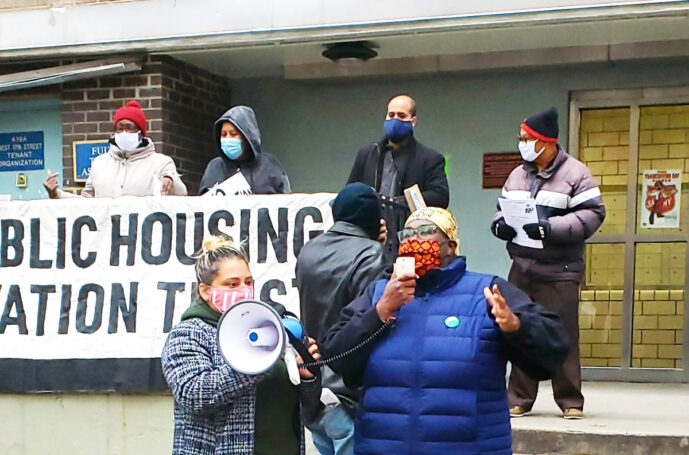
The problem with the rosy portrait painted of RAD by city officials, embellished with all the assurances and feel-good nonprofit-speak of “community engagement” and “accountability” is that there exists direct evidence of its dangers to public housing tenants. The Ocean Bay Houses in Far Rockaway, NYCHA’s flagship RAD conversion and the largest in the country with $560 million in needed repairs, was handed over to Wavecrest Management in 2016. Since the completion of the renovations, Ocean Bay holds the distinction of evicting more people over a two-year period than any other NYCHA development, more than doubling the next highest evictor. This can at least in part be explained by the fact that NYCHA waits two months before bringing nonpayment cases against tenants, while private management companies evict tenants far more avidly and efficiently.
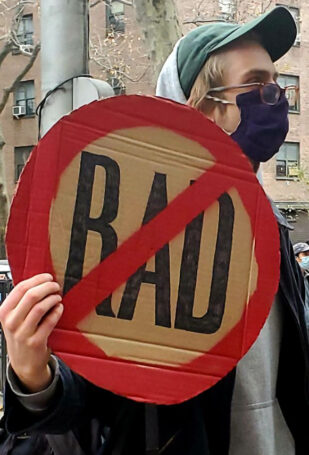 And then there is the issue of transparency. While the infusion of taxpayer-subsidized capital into Ocean Bay has indeed led to upgrades, tenants no longer have access to information on how repairs and work orders are being managed as well as when utility shut-offs for repairs are to take place. And although Wavecrest claims it is handling the issue, RAD also exempts NYCHA apartments from a major court settlement on mold cleanup known as the Baez agreement, which provides protections of a monitor and federal judge for overseeing this rampant and hazardous problem caused by decades of disinvestment. And so, while tenants have welcomed needed repairs that should have already been addressed through proper funding, the list of evidence against assurances that RAD is a good deal grows longer.
And then there is the issue of transparency. While the infusion of taxpayer-subsidized capital into Ocean Bay has indeed led to upgrades, tenants no longer have access to information on how repairs and work orders are being managed as well as when utility shut-offs for repairs are to take place. And although Wavecrest claims it is handling the issue, RAD also exempts NYCHA apartments from a major court settlement on mold cleanup known as the Baez agreement, which provides protections of a monitor and federal judge for overseeing this rampant and hazardous problem caused by decades of disinvestment. And so, while tenants have welcomed needed repairs that should have already been addressed through proper funding, the list of evidence against assurances that RAD is a good deal grows longer.
Linda, a long-time tenant of Fulton Houses, describes what she saw when the city brought Fulton Houses tenants to Ocean Bay in an effort to get them to sign on: “We went to Ocean Bay and saw what it was like, and to be honest with you, it was like being in lockdown, being in jail. You have to get permission for everything. And the repairs there are not done in a timely fashion. So, I say RAD is not the way to go.” Jasmin Sanchez, who worked as the NYCHA organizer for the most recent congressional campaign for Alexandria Ocasio-Cortez and is a lead organizer with Movement School, also addressed the tenants:
The people who live [in NYCHA developments] are 88% people of color. Poor air quality, infestations, holes, water leaks . . . it’s by design. They want us out of here so that they can convert this to a new demographic of people. . . . To get the repairs that we need, we need to stick together and organize, strategize, and mobilize our communities to continue to fight against privatization. . . . We are not second-class citizens, but that is what they treat us as.
She then spoke about the Green New Deal legislation introduced by AOC and Senator Bernie Sanders that addresses public housing by adding $172 billion in investment for maintenance and retrofitting. “We sustain public housing by investing. On the federal level, they have money for everything that is morally corrupt: wars, pharmaceuticals, bailouts, everything, but what about the 600,000 plus NYCHA tenants here in New York City? They suddenly ain’t got nothing for us.” Ramon Pebenito added:
Senator Salazar, for whom I work, issued a bill in 2019. It’s a multi-millionaires tax, that is to say that it only affects you if you make more than 1 million, and with that tax, we can directly credit NYCHA with funds to go to the capital repairs. So there is an alternative. But they feast on your worry and your inaction, they love it when you are too worried to make a calm decision. RAD is a disaster, and it will be a disaster here too.
Ben Bath with the New York Young Communist League and the CPUSA, which organized the rally, also spoke:
Everybody has the right to live, but in this city in 2020, do working people have a right to live in this city? Do people who grew up here, who spent their lives here, do they have a right to live? . . . We have to unite and fight against the real-estate interests that are destroying this city.
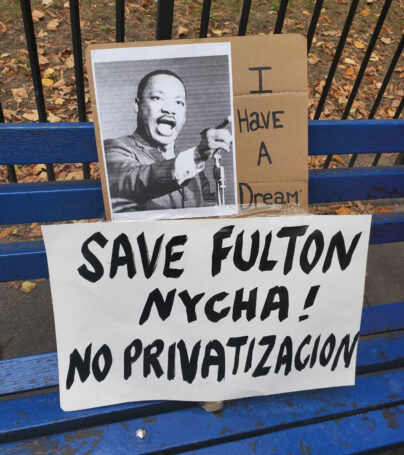 Still, NYCHA’s new chairperson, Gregory Russ, is convinced that RAD is the only way to provide the nearly $40 billion in repairs needed citywide. Implicit in this rejection of any other possibility to fund NYCHA is a recognition of the political battle necessary to extract the funding at the city, state, and federal levels — and a refusal to even entertain political struggle as an option. RAD is chemotherapy, according to Victor Bach, a “longtime analyst”; in other words, an unpleasant but necessary shock treatment to a cancer-ridden body. The cancer of the domination of capital over need, and the corresponding disinvestment from public good, aren’t further interrogated. The arguments for RAD are ultimately the same issued by all those “concerned” about budgetary shortfalls for public projects of all kinds: because there isn’t any money, let the market fill in the gaps, “unlocking” capital that hitherto had been hidden and inaccessible. What this always amounts to, and in the case of RAD is just another proclamation of the same, is the refusal of public officials to squeeze their benefactors for the money needed to fund the people. With a more aggressive taxation policy targeting wealthy individuals and corporate wealth, the shortfalls that beleaguer us could be surmounted so that we could begin the necessary work of putting people back to work in the service of the public.
Still, NYCHA’s new chairperson, Gregory Russ, is convinced that RAD is the only way to provide the nearly $40 billion in repairs needed citywide. Implicit in this rejection of any other possibility to fund NYCHA is a recognition of the political battle necessary to extract the funding at the city, state, and federal levels — and a refusal to even entertain political struggle as an option. RAD is chemotherapy, according to Victor Bach, a “longtime analyst”; in other words, an unpleasant but necessary shock treatment to a cancer-ridden body. The cancer of the domination of capital over need, and the corresponding disinvestment from public good, aren’t further interrogated. The arguments for RAD are ultimately the same issued by all those “concerned” about budgetary shortfalls for public projects of all kinds: because there isn’t any money, let the market fill in the gaps, “unlocking” capital that hitherto had been hidden and inaccessible. What this always amounts to, and in the case of RAD is just another proclamation of the same, is the refusal of public officials to squeeze their benefactors for the money needed to fund the people. With a more aggressive taxation policy targeting wealthy individuals and corporate wealth, the shortfalls that beleaguer us could be surmounted so that we could begin the necessary work of putting people back to work in the service of the public.
Images: New York YCL/CPUSA.


 Join Now
Join Now